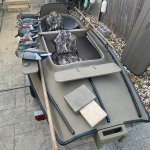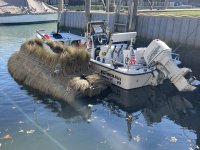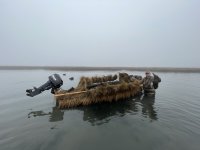Steve Sanford
Well-known member
All~
I suppose I am known as an Old School fellow - and I cannot deny that characterization - even embrace it. Nevertheless, I try to keep an open mind and am always on the lookout for true improvements - or at least sound alternatives. Thus, I have put webbing on recent duckboat restorations instead of the traditional wooden thatch rails.
I have been around Salt Hay (aka "thatch" on Great South Bay) and thatch rails all my life. I have come to the conclusion that they were probably "invented" on Long Island, sometime in the 1900s. Among the many vessel types we put into the "grassboat" category, I have never seen one on LI without thatch rails. Barnegat Bay Sneakboxes may have had toe rails - to keep hay or wrack or ice - on the deck for hiding - and I see no long-term evidence of rails on gunning boats from New England. (Of course, I am always happy to be shown evidence otherwise - and imagine that thatch rails - whatever they are called - may have been developed independently in more than one locale: convergent evolution.)
I have replaced thatch rails with wooden - either treated lumber (carefully selected for grain) and Mahogany on dozens of gunning boats over the years. Here is my Sneakbox RED-LEG with its new Mahogany thatch rails (but tightly curved toe rail for the spray dodger is PVC).
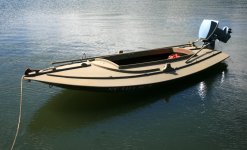
Here is a South Bay Duckboat I rehabbed in early '23 - all the rails of conventional wood - with glued-on spacer blocks.
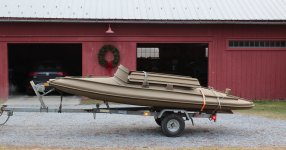
I just completed this South Bay with wooden thatch rails only down the center line - but with polypropylene webbing elsewhere.
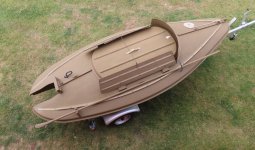
This is the first boat I did with webbing. (The rows of heavy tarred line on the frames have bundles of hay lashed to them).
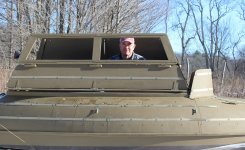
Here it is all thatched up:
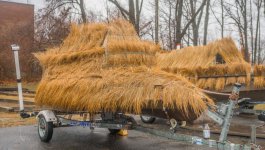
I have long used webbing for other duckboat purposes. Here it is on the RED-LEG's spray dodger: - sewn on

Here on an outboard cover. For both the dodger and the motor cover, bundles of hay get lashed to the webbing.
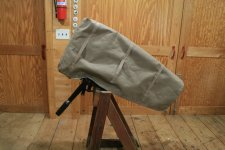
And I have departed from wood-for-thatch elsewhere. Two rows of shock cord hold the thatch on my gunning coffins in recent years:
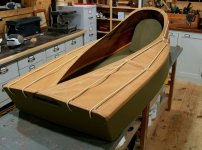
Scores (hundreds?) of bundles of Salt Hay get lashed to both rows with biodegradable twine. I use square (aka reef) knots for this task.
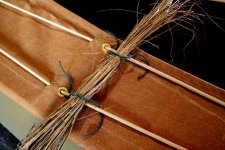
I have been told that webbing has been used on Marsh Hawk brand duckboats for many years. One owner told me he has had 17 seasons with the originals. I have also learned (not sure how or where) that polypropylene is better than nylon for this use. I use heavyweight 1-inch polypropylene in Khaki. It comes in several duckboat-compatible hues from Strapworks. https://www.strapworks.com/1-inch-heavyweight-polypropylene-khaki
I fasten every 10 or 12 inches - with a s/s fender washer and either self-tapping panheads - or panhead machine screws backed up below with a standard washer and a Nyloc nut. I sand each washer with 220-grit paper, wash with acetone, then spray with self-etching primer. The screws I rinse in acetone then spray.

A closer look for dimensions:
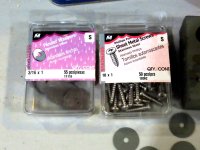
I "bore" the fastener holes with a heated 16-penny finishing nail - held with a Vise-Grip. I cut the ends with my favorite new toy: a good quality hot knife. I double the ends, hold them with a spring clamp, then poke the red-hot nail through. I "stir" the nail around to be sure the hole is large enough for the #10 fasteners.
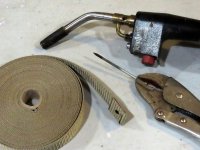
On flap boards, I use brass machine screws - and sand the ends flush after tightening to avoid wear and tear on gunners' hands and dogs' noses. Of course, the slots in the screw heads must be "calendared" - so they all align lest they flare Old Mister Black Duck. BTW: I do not bother to paint raw brass, no matter how shiny. It will turn a gorgeous bronze of verdigris soon enough.
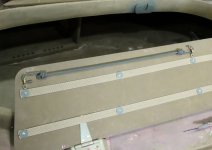
Wooden thatch rails remain a thing of beauty. But - they are more expensive for both materials and labor.
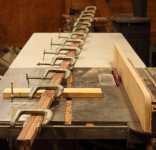
As with anything, attention-to-detail is its own reward.
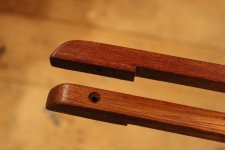
I am sure I have not made my last wooden thatch rails - and will certainly make more of those down the center line of just about any gunning boat where cleats, eye bolts, light stanchions and grab handles all need a good foundation...
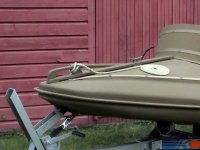
...but webbing has earned a place on gunning vessels, in my view.
Hope this helps!
SJS
I suppose I am known as an Old School fellow - and I cannot deny that characterization - even embrace it. Nevertheless, I try to keep an open mind and am always on the lookout for true improvements - or at least sound alternatives. Thus, I have put webbing on recent duckboat restorations instead of the traditional wooden thatch rails.
I have been around Salt Hay (aka "thatch" on Great South Bay) and thatch rails all my life. I have come to the conclusion that they were probably "invented" on Long Island, sometime in the 1900s. Among the many vessel types we put into the "grassboat" category, I have never seen one on LI without thatch rails. Barnegat Bay Sneakboxes may have had toe rails - to keep hay or wrack or ice - on the deck for hiding - and I see no long-term evidence of rails on gunning boats from New England. (Of course, I am always happy to be shown evidence otherwise - and imagine that thatch rails - whatever they are called - may have been developed independently in more than one locale: convergent evolution.)
I have replaced thatch rails with wooden - either treated lumber (carefully selected for grain) and Mahogany on dozens of gunning boats over the years. Here is my Sneakbox RED-LEG with its new Mahogany thatch rails (but tightly curved toe rail for the spray dodger is PVC).

Here is a South Bay Duckboat I rehabbed in early '23 - all the rails of conventional wood - with glued-on spacer blocks.

I just completed this South Bay with wooden thatch rails only down the center line - but with polypropylene webbing elsewhere.

This is the first boat I did with webbing. (The rows of heavy tarred line on the frames have bundles of hay lashed to them).

Here it is all thatched up:

I have long used webbing for other duckboat purposes. Here it is on the RED-LEG's spray dodger: - sewn on

Here on an outboard cover. For both the dodger and the motor cover, bundles of hay get lashed to the webbing.

And I have departed from wood-for-thatch elsewhere. Two rows of shock cord hold the thatch on my gunning coffins in recent years:

Scores (hundreds?) of bundles of Salt Hay get lashed to both rows with biodegradable twine. I use square (aka reef) knots for this task.

I have been told that webbing has been used on Marsh Hawk brand duckboats for many years. One owner told me he has had 17 seasons with the originals. I have also learned (not sure how or where) that polypropylene is better than nylon for this use. I use heavyweight 1-inch polypropylene in Khaki. It comes in several duckboat-compatible hues from Strapworks. https://www.strapworks.com/1-inch-heavyweight-polypropylene-khaki
I fasten every 10 or 12 inches - with a s/s fender washer and either self-tapping panheads - or panhead machine screws backed up below with a standard washer and a Nyloc nut. I sand each washer with 220-grit paper, wash with acetone, then spray with self-etching primer. The screws I rinse in acetone then spray.

A closer look for dimensions:

I "bore" the fastener holes with a heated 16-penny finishing nail - held with a Vise-Grip. I cut the ends with my favorite new toy: a good quality hot knife. I double the ends, hold them with a spring clamp, then poke the red-hot nail through. I "stir" the nail around to be sure the hole is large enough for the #10 fasteners.

On flap boards, I use brass machine screws - and sand the ends flush after tightening to avoid wear and tear on gunners' hands and dogs' noses. Of course, the slots in the screw heads must be "calendared" - so they all align lest they flare Old Mister Black Duck. BTW: I do not bother to paint raw brass, no matter how shiny. It will turn a gorgeous bronze of verdigris soon enough.

Wooden thatch rails remain a thing of beauty. But - they are more expensive for both materials and labor.

As with anything, attention-to-detail is its own reward.

I am sure I have not made my last wooden thatch rails - and will certainly make more of those down the center line of just about any gunning boat where cleats, eye bolts, light stanchions and grab handles all need a good foundation...

...but webbing has earned a place on gunning vessels, in my view.
Hope this helps!
SJS


